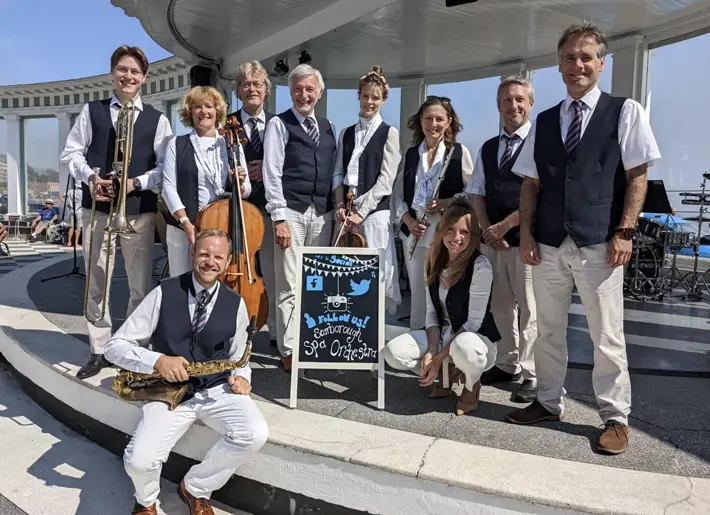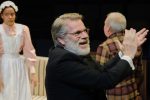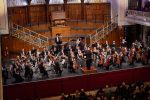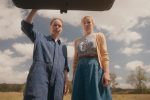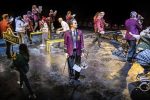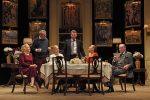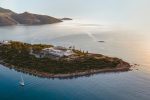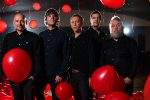Scarborough Spa Orchestra – Review – Scarborough Spa
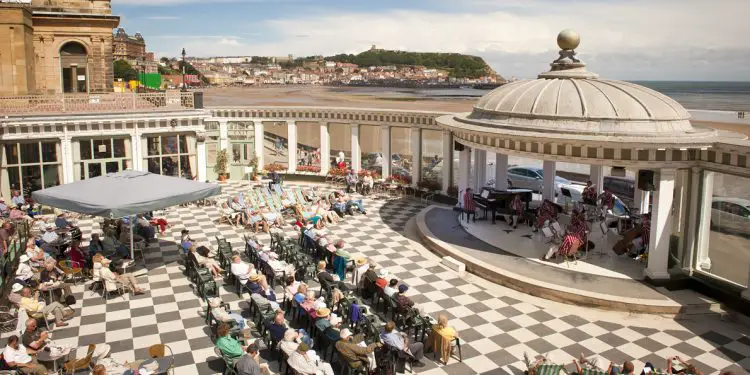
By Elizabeth Stanforth-Sharpe, July 2023
When Thomasin Farrer discovered wells of medicinal spring waters at the base of the cliffs on the south side of Scarborough, in the 1700s, thousands of visitors flocked to the town to ‘take the waters’. The Corporation built cisterns to house the water, until, later, it became necessary to build a ‘Spaw House’ – a wooden structure where the water from the springs were bottled, sold and dispensed – and Scarborough quickly became established as a fashionable seaside resort and spa town. The Spaw House had several setbacks as staiths were washed away or damaged by the sea, and then, in 1737 irreparable disaster struck. A major landslip crushed the Spaw House and blocked up the wells.
Quick action was called for if Scarborough was to retain its important tourism status. Within five weeks, the wells had been cleared, and by 1739, a more substantial bath house was constructed with steps allowing access to bathe in the healing waters, and a bonus was that during the renovations it was discovered that the wells actually contained two separate types of water, each with their own distinctive curative properties. Twice the healing potential meant twice the tourism reach.
In 1827, Cliff Bridge was opened, providing better access to the Spa facilities, and, as even more people came, the buildings grew grander and more elaborate. In 1839, the Gothic Saloon, designed by Henry Wyatt, which held a complex of a concert hall, a garden, a promenade area, and a court for outside concerts, was opened, but already proved to be too small for the crowds that came. Incidentally, Wyatt also designed the residence of the prominent Scarborough banker John Woodall, a building that is now Scarborough Town Hall.
By 1858, Joseph Paxton, the architect responsible for Chatsworth House, had been brought in to design a central assembly hall with adjoining galleries; to extend the sea wall allowing for a larger promenade area and carriage drive, a colonnade with shops, a bandstand, the Prospect Tower, and the magnificent Italian Steps (which still provide the perfect place for Insta selfies today). Scarborough Spa became the biggest concert hall outside of London, and in its heyday attracted over 4000 visitors a day during the summer season. England’s first cliff tram was added in 1875, to add another novel attraction and increase access to the Spa.
When the saloon was destroyed by fire in 1876, the response once again was to build back better than before. The lavish Grand Hall came into being, and the Spa had added embellishments, designed by Thomas Verity. Later additions of a restaurant, a ballroom, the marble forecourt-colonnade, a swimming pool, a roof garden and a succession of extensions and refurbishments have ensured that the complex has always been in the forefront of elegant northern buildings, and today regularly draws national and international conferences in addition to tourists and a loyal local clientele.
But what of Mrs Farrer’s discovery that began all this? By the 1800’s, the importance of the music and entertainment offered surpassed that of the former interest in taking the waters, and over the years the chemical composition of the wells was noticeably changed. By the mid 1960’s, consumption had ceased, and health and safety prohibitions made the wells inaccessible to the public, though their location can still be found, beneath the island opposite the shops.
In 1912, The Spa, through the inspiration of the English composer and conductor Alexander ‘Alick’ Morvaren Maclean, established its own professional seaside orchestra. Maclean conducted the orchestra until 1935, one year before his death. There was originally an ensemble of thirty-five professional musicians, who gave daily concerts in the Grand Hall and Sun Court, performing musical pieces ranging from the classical repertoire, Viennese waltzes, operettas and popular songs of the day. Faces have inevitably changed, but today The Scarborough Spa Orchestra is the last remaining professional seaside orchestra in the country, and they perform an exhausting number of concerts throughout the summer season, as well as programmes for new year and festive entertainment.
At the opening concert for the 111th season, I spoke with some of the audience members. One local lady beamed with delight and told me she’d had a season ticket for nearly sixty years, had hardly missed a performance, rain or shine, and missed them tremendously when they weren’t playing. For a couple recently moved to the town, it was an opportunity to explore more of what Scarborough had to offer. A teenager and her mum, on their annual holiday to Scarborough, both agreed that it was always a high point of their week to visit an orchestra concert at The Spa; evidenced by their animated response to the music. One lovely gentleman, dressed in a white dinner jacket and a sporting a rather wonderful bowtie, opened up his sandwich box in the interval, and told me, “My wife and I used to do just this. Dress in our finery and listen to the concerts as we ate our picnic.” His eyes sparkled with tears as he continued, “Now, I come for the both of us, and remember her”.
This kind of loyalty isn’t just about nostalgia, though that is certainly there. It is about important life moments and the memories that those moments bring to the surface. How many who attended the orchestra’s Teddy Bear’s Picnic events as children have carried that recollection with them and later brought their own children? How many, “They’re playing our song” moments, birthday celebrations, and anniversary waltzes are evoked in the requests’ concerts? And how many little ones once ‘conducting’ the orchestra from their deckchairs were influenced to start an instrument themselves?
Sunday evening was wet, miserable, and dark, and the waves were lashing the sea wall; conditions more becoming of November than July, but it didn’t matter one jot. The Grand Hall was stately, warm and welcoming, as the Musical Director, Pianist and Presenter, Paul Laidlaw, introduced the orchestra.
Laidlaw was born in Tynemouth, but studied at the University of York, and for five years he was resident Musical Director at York Theatre Royal. His expansive career has taken him everywhere, earned him gold discs and accolades. In Scarborough, he accompanied West End star Janie Dee and the full company to celebrate Alan Ayckbourn’s birthday, and it is to Scarborough he returns to co-ordinate The Spa season of concerts.
Violinist and Violist, Rebecca Smith, annually makes Scarborough her summer home, playing nine different concerts every week. For the rest of the year, Smith appears with an extensive selection of orchestras – the BBC Scottish Symphony Orchestra, RSNO, Scottish Opera, Scottish Ballet, Manchester Camerata, Northern Ballet and Opera North, to name but a few. She has a passion for Chamber music, but also performs brand new pieces with Dark Invention, and 17th century music with the Meiningen Ensemble at Huddersfield University.
Cellist, Diane Stewart, has been with The Spa Orchestra for twenty-seven years, spending the rest of her year teaching music, accompanying acts at the Open-Air Theatre, performing in Castle Howard concerts, and much more.
Double Bassist, Lisa Featherston, is a Hull lass who trained at Royal Northern College of Music. Amongst her long string of credits, Featherston has played for Top of The Pops, BBC Children in Need, Birmingham Royal Ballet, and the George Michael Tour 2012.
Kathryn Seabrook is well known in Scarborough as a music teacher who plays Flute, Piccolo and Saxophone, and as a deviser of fun music sessions for babies and pre-schoolers. She has been a member of The Spa Orchestra for thirty-six years and, unsurprisingly, as well as playing her instruments, she organises the Teddy Bear’s Picnic and the children’s concerts. Seabrook who has worked on international hits including ‘Evita’, ‘My Girl’ and ‘Barnum’, is married to Graham Quilter, who plays Clarinet and Saxophone. Kathryn and Graham are the parents of talented sons Ben and Adam, both of whom went on to study music. Adam is playing Trombone this season.
Jonathan Sage, on Bassoon, Clarinet and Saxophone, is a York based musician who divides his time between orchestral playing, chamber music, solo performance, pit work and teaching. He is a founder member of the contemporary music group Dark Invention, has recorded extensively, and lectures at the University of York.
“Brimming with energy”
Trumpeter, Mark Addison, always brings a smile to the Spa stage, an experience he describes as very different from his substantial work with orchestras, theatre tours and the BBC, “I have to say, for me, this is the hardest gig I have ever done. I started my freelance career while still at college in Manchester, playing with the Halle, RLPO and others. Playing Mahler and Bruckner symphonies, not as hard! I did 3 years in London’s west end doing a show, including a 3-show matinee day, not as hard. The amount of actual playing required in one concert here is highly demanding on the tiny amount of lip tissue a trumpeter uses and unlike any other instrument, a brass instrument only makes a sound if you drop it, it is the lip buzzing the lips that creates the note, the trumpet is purely an amplifier, similar to a vocalist. Imagine singing for an hour and a half, you soon get a sore throat.
That said, it is also a fantastic job. The versatility of music means you learn to play many different tunes in many styles.”
Concluding this line-up of top-notch instrumentalists is Percussionist, Michael Harper. Harper is a freelance musician who has worked with, amongst many others, Opera North and the BBC Philharmonic.
The magic of The Scarborough Spa Orchestra is that every concert is different and combines a variety of styles, ensuring that there is something that will appeal to everyone. They pride themselves on never repeating a piece in a season.
The 2023 Grand Opening Concert got off to a rousing start with Laidlaw’s arrangement of Bernstein’s ‘Candide Overture’, followed by the elegance of American composer Leroy Anderson’s ‘Belle of the Ball’, before the train was rolling out of the station for a touch of forties big band swing in the form of Harry Warren’s ‘Chatanooga Choo-Choo’. Then we were straight back in the 1889 court of Emperor Wilhelm II for ‘Emperor Waltz’, written by Johann Strauss II to seal the friendship between the empires of Austria and Germany.
There’s just enough time to bow to our partners and take a breath before Laidlaw is telling an anecdote about the formidable Biddy Baxter as a segue to a piece written by a Lancashire solicitor who composed music as a hobby – Herbert Ashworth-Hope’s ‘Barnacle Bill’ – better known as the Blue Peter theme tune.
Vocal chords given a warm-up through humming along, the audience are now given the opportunity to sing along to a selection of tunes from Lerner and Loewe’s My Fair Lady. A fun bit of trivia is that Loewe wanted to call the musical ‘Fanfaroon’, but Lerner felt it was too similar to their previous Brigadoon, so with previews looming, they plumped for My Fair Lady though both had their doubts it was the right choice. With a bit of bloomin’ luck, it caught on.
The concert programmes begin to be put together in January, and perhaps they hadn’t quite envisioned how much the next choice would reflect the weather outside. It’s Johann Strauss II’s famous ‘Thunder and Lightning Polka’, brimming with energy, clarity and Viennese sparkle.
Then, we go out to the interval tapping our toes and singing along to a medley of music from Mamma Mia, composed by Abba members, Benny Andersson and Björn Ulvaeus.
A ‘Super Trouper’ is a make of spotlight used in large venues; I’m told. The members of The Scarborough Spa Orchestra had already proved themselves to be ‘super troopers’ through a demanding first half, but they didn’t get time to rest before the second, interacting with audience members, catching up with regulars, and answering questions. The spotlight was continually on them.
Ice creams and drinks in hand, it was time for the second half of the programme, and we were back in 1955, with Eric Coate’s ‘The Dambusters March’, and I couldn’t fail to notice one Lincoln City supporter in the Grand Hall stretching out his arms and swooping them aeroplane-like.
As if that hasn’t been stirring enough, another opportunity to air our lungs followed in the form of a blend of John Lennon and Paul McCartney numbers arranged by Laidlaw. We’re swiftly transported from 1960’s Beatlemania to the 1930’s jazz age of a criminal Chicago, with a medley of John Kander’s compositions as arranged by Rob Fisher.
Then it’s back to an Italy of 1890, and a lovely piece of operatic history. The musical publisher Edoardo Sonzogna announced a competition for young Italian composers who had yet to have an opera performed on the stage. The best three one-act operas would be performed in Rome. Petro Mascagni was a last-minute entrant – and then only because his wife retrieved the piece after he had proclaimed it of no worth and sent it in for him. ‘Cavalleria Rustica’ (‘rustic chivalry’) was one of the three winners, was performed at Teatro Costanzo in Rome, with an audience that included Queen Margherita (she of pizza fame) and was so loved that Mascagni took 40 curtain calls. Perhaps it is equally known today for the role it played in The Godfather: Part III. The orchestra treated us to a very moving rendition of the Intermezzo and Easter Hymn. Powerful and tender, and to my mind, one of the most beautiful pieces of music ever composed; I’m so glad Mascagni’s wife rescued it!
A change of tempo as the orchestra takes us to York’s own, the late John Barry’s ‘Goldfinger’, arranged by Laidlaw; that iconic two-note phrase in the introduction, and then a piece imbued with steamy sensuality and the heady richness of the brass instruments.
The penultimate piece brought us right back down to Yorkshire earth. Ronnie Hazlehurst’s theme tune for Last of the Summer Wine had us all wandering down those Holmfirth streets in our imaginations, watching Norah Batty sweeping the steps and Compo Simmonite kicking up the leaves in his wellies. Homely, heart-warming sentimentality.
There is an apocryphal story from the premiere performance of Maurice Ravel’s ‘Boléro’ that a woman shouted repeatedly from the audience that Ravel was mad. It was the last piece composed before the effects of his neurological illness forced him to retire. When told of the woman’s remarks, he is reported to have said that she had understood the piece better than most. Building from a repeated melody until the tension explodes into a burst of fireworks, Ravel himself predicted that most orchestras would refuse to play it, regarding it as too mechanical. He was wrong, of course, and whilst it is written for a much larger orchestra, The Scarborough Spa Orchestra used it well, to bring a celebratory flourish to the end of their Grand Opening Concert of the 2023 Summer Season of Music.
The weather did its worst, but it couldn’t dampen the glory of a wonderful evening. The spa waters may no longer heal, but the orchestra still does a fine job of lifting the spirits.
There is a full list of the concerts on scarboroughspa.co.uk
